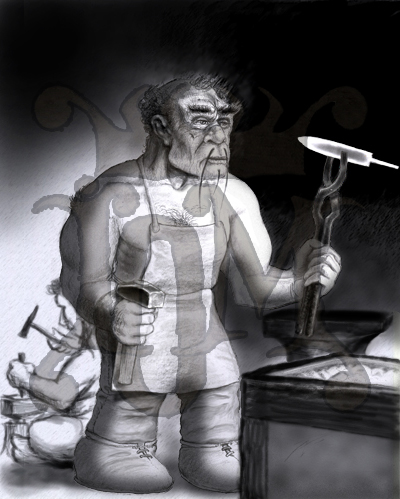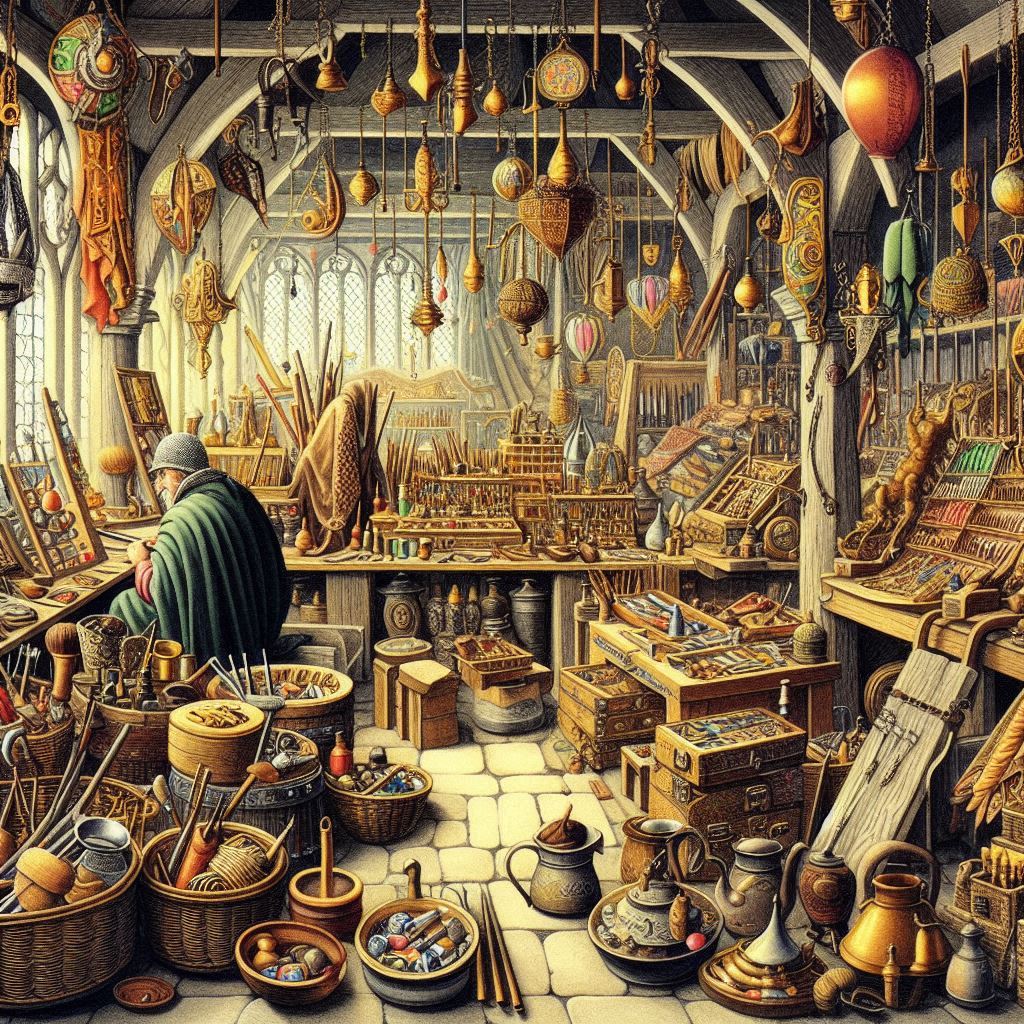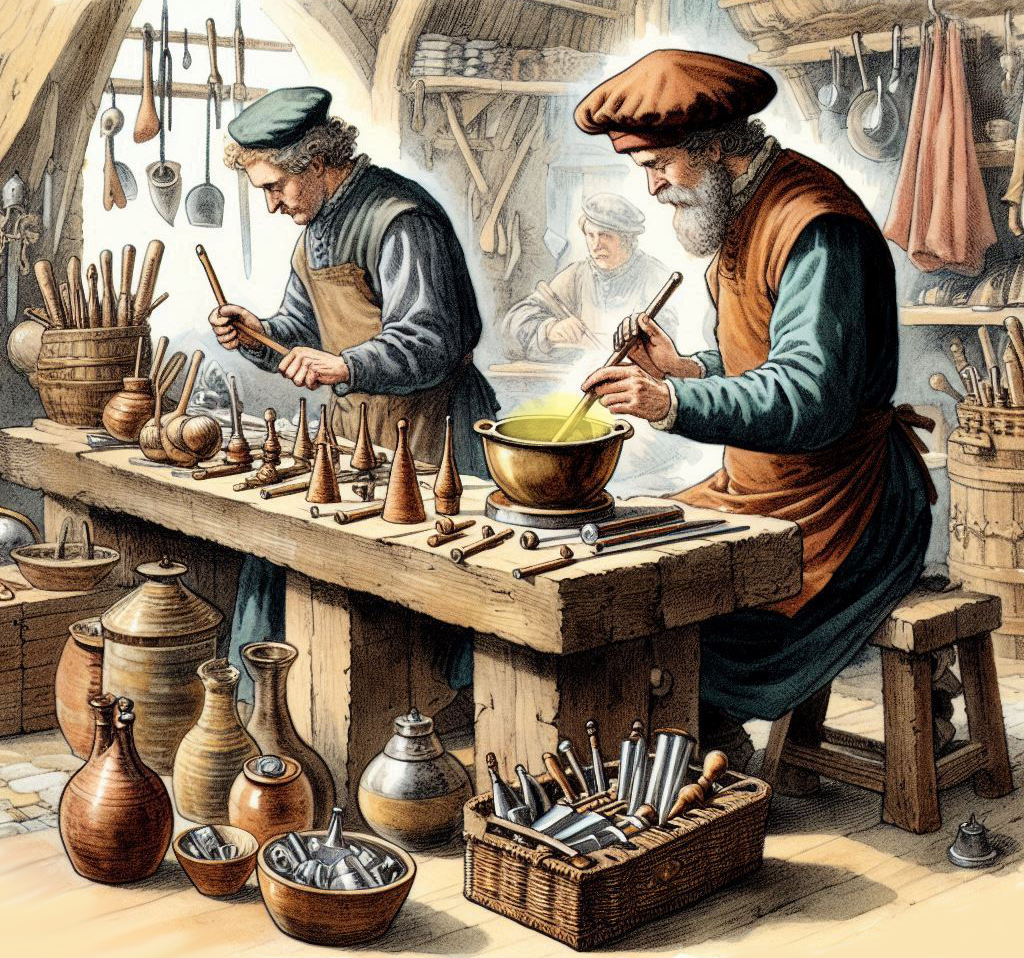Crafting

Apprentice (I)
Novice (II)
Journeyman (III)
Chief (IV)
Master (V)
Lord (VI)
Overlord (VII)
Grand lord (VIII)
Legend
“Legendary Items are created by the greatest Smidhr, in the centre of Mt. Vula.”
Description

Crafting in the world is a refined and complex art, shaped by centuries of practice and knowledge, evolving from the crude works of the Dark Ages. What began with simple survival skills, such as roasting a fish or sewing a fur, has developed into an intricate system where individuals harness their talents to create items of extraordinary value. Whether shaping raw materials into basic tools or imbuing legendary items with powerful enchantments, crafting is a pillar of society, reflecting both individual skill and communal heritage. The most revered crafting takes place at the heart of Mt. Vula, where mana itself swirls into the realm, empowering artisans to reach heights unattainable elsewhere.
At its core, crafting is about transforming raw materials through a step-by-step process of refinement. A skilled crafter moves from gathering these raw resources to converting them into more refined components—whether wood, ore, or textiles. As they refine materials into resources and craft items, their skill rank dictates the purity and quality of the final product. A novice may create items of practical use, but only the highest-ranked crafters, such as Masters and Lords, can push their creations to near-perfection, unlocking the potential for enchantments and greater enhancements. The crafting system is hierarchical, with ranks like Apprentice, Journeyman, and Lord, each tied to increasing skill levels and the ability to work with higher-purity materials.
Besides combining components, crafted items reflect the purity of their materials and the skill of the artisan. Every element, from the pommel to the blade of a sword, carries its own purity, which directly influences the final item’s capabilities. The crafter’s skill determines not only how these components come together but also how enhancements can be applied, limiting their potency based on the lowest purity involved. In rare instances, the gods themselves may intervene, infusing a craft with divine power, further raising its value and significance in the world.
Skjald Valgrif
History
Gathering Raw materials for refinement has been done since the World came to be. One could argue that the first boiled or roasted fish, the first prepared vegetable, or the first worn fur were the first crafts. So… when it began, it was unknown and uncertain, but today’s crafting is much more complex than the crude work of the Dark Ages.
As good as anyone can make crude and simple things to sustain daily life, at some point, they just need to be better, or an individual with talen is spotted. These are taking crafting beyond rag-tag stuff and starting their climb up the crafting system ranks. Ranking is defined by Crafters and Skills. and normally starts at Apprentice and raises to Lord or more. Crafting sees its greatest unfold at Mt. Vula, in which many sidecaves open out into ‘Crafters Heaven’—an immense crater where swirling Mana forms a rooftop, blocking sunlight from pouring into our world. As it swirls down, it slowly crystallises, and the weight forces it downward and out at the great centre pillar.
The rim of every colour cracks and breaks like a glazier, tumbling down into the steaming heads of Lava Imps. Making them come alive with sizzling tongues and gleaming eyes for a while, aiding whatever works at the forges and anvils. Running out of energy, they return to the piller once more, but not at the same colour they rose from, until they have rested at all other colours.
Skjald Ulrich
Organisation

Its worth noting that crafting can be both a resource, an item, or really complex objects.
Its worth noting, that many can cut a wooden figure, cook a meal, or behead a chicken. But its not until one begins to study the types, ores, components, flavours, cut angles, etc. That one goes from what guilded and taught people call a Rag Tag.
Apprentice (I)
Recipes from 1 up to 125.
Novice (II)
Recipes from 126 up to 325.
Journeyman (III)
Recipes from 326 up to 500.
Chief (IV)
Recipes from 501 up to 650.
Master (V)
Recipes from 651 up to 775.
Lord (VI)
Recipes from 776 up to 875.
Overlord (VII)
Recipes from 876 up to 950.
Grand lord (VIII)
Recipes from 951 up to 1000.
Skjald Sigurd
When crafting, it’s normally one of these:
- Resource: Are the results of refinement of a Raw material.
- Item: the alteration of resource(s) into an item
- Object: The merge of items into an object
Crafted items have an average purity of the raw materials used, up to the skill of the crafter. Crafted objects similarly have an average purity of items used, up to the skill of the crafter. Thus, don’t give the purest raws or items to an apprentice. Enhancers can’t add more energy to an object than its purity or their skill rank. Thus, don’t waste the best on a low-ranked enhancer.
Skjald Vinotis
Lets assume a Grand Lord with more than the required 951 in skill, craft a sword; pommel (963), handle (958), guard (952), and blade (959). That it’s a Grand Lord making it, allows for 8 enhancing slots. Should any of the components already have enchantments, they are dissolved in the sword crafting process.
Although none of the enchantment slots can hold energies above the objects lowest purity (952) in potency. The purity of shards used must exceed 952, to be able to influence enhancing of the world item/object. This means, that two merged radiant shards wont suffice, as they are merely a celestial at purity 951. The merged celestial, needs another merge to raise its potency.
Skjald Sejrik
Special
Crafting can suddenly be aided by one of the Gods.
Skjald Yell'a'Beard
Last Updated on 2024-10-18 by IoM-Christian
